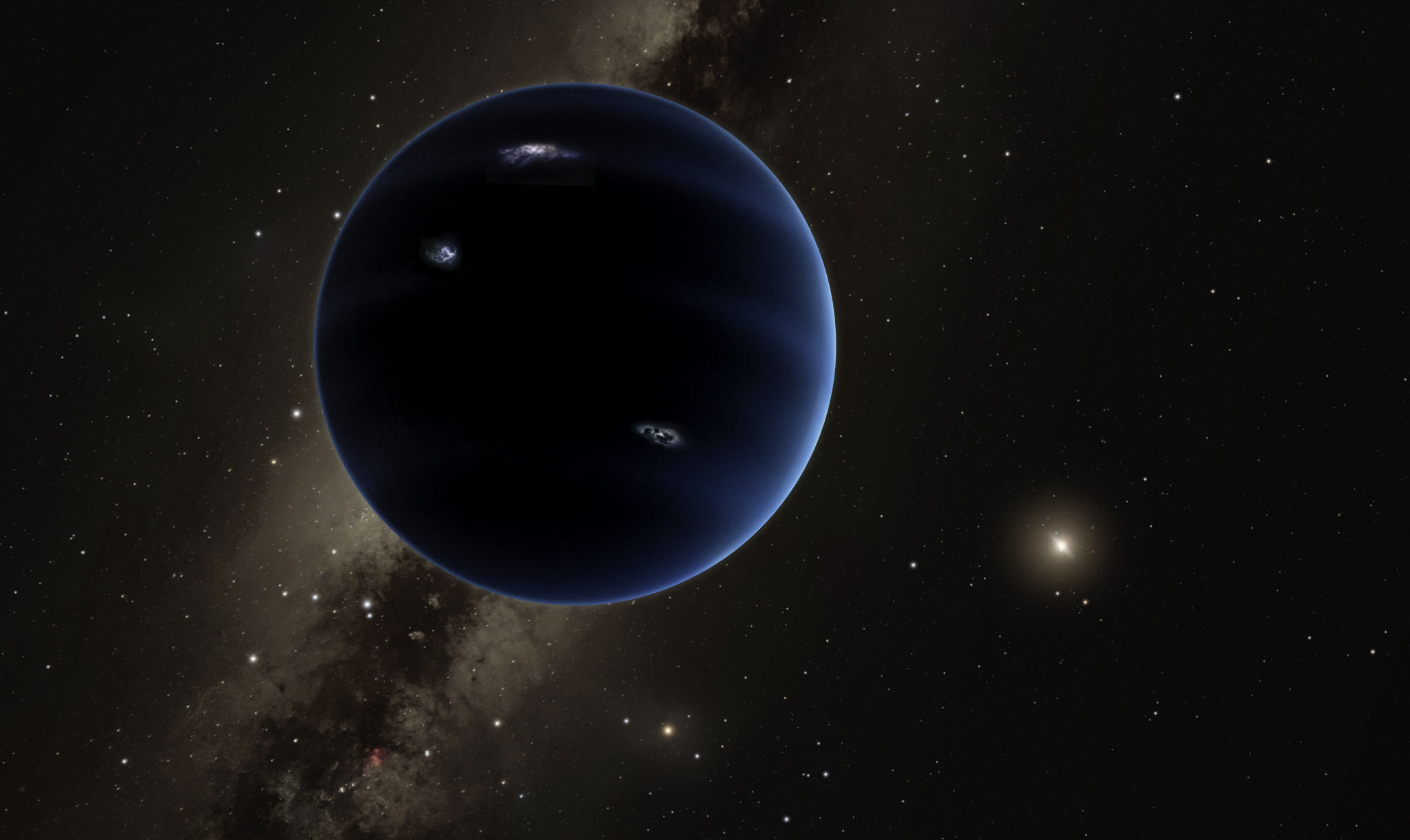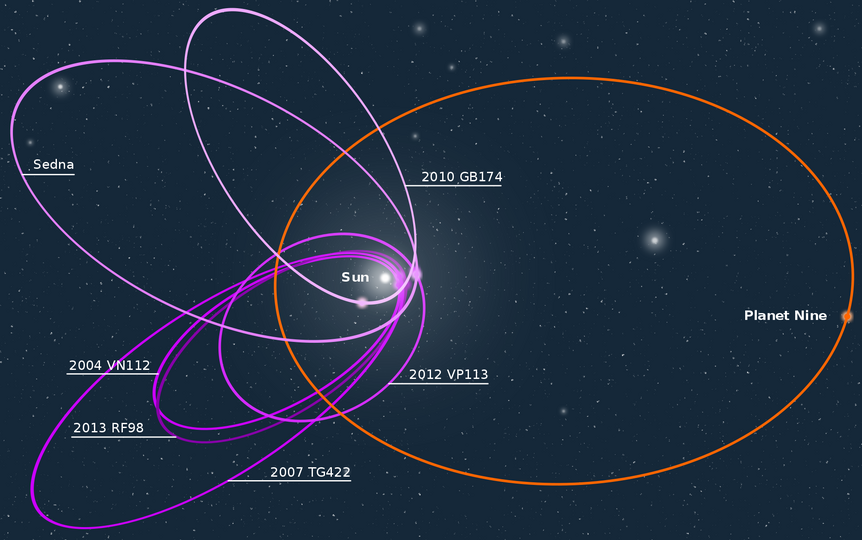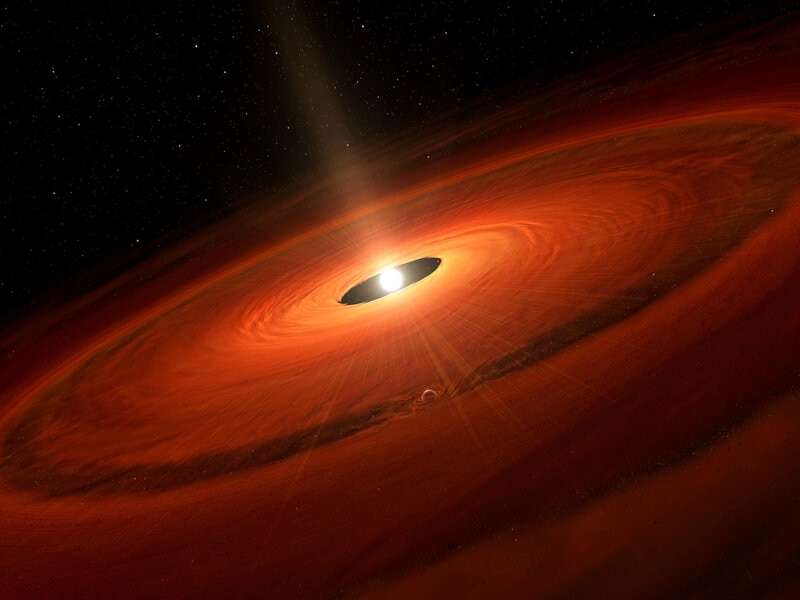Create a free profile to get unlimited access to exclusive videos, sweepstakes, and more!
Does Planet 9 Exist? <All signs (still) point to 'yes'>

Does our solar system have a ninth planet?
And I don't mean Pluto* — I mean a major planet, something big and cold and dark and lurking in the outer solar system far, far beyond the orbit of Neptune.
There's reason to think it's out there. Starting a few years back, astronomers started finding objects past Neptune (called Trans-Neptunian Objects, or TNOs) that were on weird orbits. I've explained this in detail before, but basically these are icy bodies a hundred kilometers across or more, and their elliptical orbits were aligned in way that didn't seem possible by chance. They can be randomly tipped and rotated, pointing in any which-way, but in fact they all seemed to have their long axes and poles roughly aligned. That can happen naturally if there's a big massive object out there, as-yet-unseen planet well beyond Neptune. If they pass by this planet on their travels around the Sun, its gravity alters their orbits, aligning them.
Interestingly, there has been some back-and-forth between astronomers asking if these alignments are real or if they are an illusion, the result of some bias in the observations. The good news is that astronomers Mike Brown and Konstantin Batygin (who have been the leading force behind the idea of Planet Nine being out there) have published a paper showing that the alignments are not from any observation bias, and in fact the chance of the alignments being a coincidence is just 0.2%... or, to make it more clear, the chance of the alignments being real is 99.8%.
So yeah, cool. That's a pretty good bet. So if they're real, where's Planet Nine?
Astronomers have been actively searching for it for a few years now, and haven't (yet) found it (my scicomm colleague Shannon Stirone wrote an enjoyable longread article about Brown's and Batygin's adventures looking for the planet). It's a big sky and a distant, faint planet, so it may yet take some time.
In the meantime, though, it's worth wondering if maybe there are other explanations for the strange TNO alignments. Could there be something else out there, not a planet, that could do the same thing?
Some astronomers wondered exactly that, and just published their results about it. They posit that instead of a single planet, maybe there's a collection of objects out there, each much smaller than a planet, but enough of them to add up to the same mass as a planet. They would be distributed in a flat disk out past Neptune. If a disk such objects existed, could it also align the orbits of the other TNOs?
The answer is yes, it could. The astronomers ran through a variety of scenarios and found that such a disk could do the trick. Neat!
So, case closed, right? No need for Planet Nine! After all, a press release was issued with the headline, “Mystery orbits in outermost reaches of solar system not caused by ‘Planet Nine', say researchers”.
Yeah, well, cool your thrusters, folks. That's not quite accurate.
First of all, just because an alternative exists doesn't mean Planet Nine doesn't. All they can actually say is that their scenario explains the same phenomena Planet Nine does. So in truth it doesn't preclude Planet Nine.
But more importantly, does their explanation make sense?
That's an interesting question. For one thing, the disk they need to explain the orbits of those weird TNOs needs to have substantial gravity. In total, the objects in their disk have to add up to a lot of mass — about ten times the Earth's mass. That's about the same mass expected for Planet Nine, and that's not a coincidence. The way the math works out, this disk is basically just Planet Nine crushed up into lots of bits and scattered around the Sun. The effect either configuration disk or planet, has on the TNOs is the same.
That's a problem. These objects individually are small compared to Earth, so you'd need a whole lot of them to add up to that much mass. It strikes me that such objects would be observable, but none has been found (yet).
Also, theoretical models of how objects form and behave in the outer solar system, as well as actual observations of such objects in sky surveys, show that at most there should be a few tenths of an Earth mass of stuff out there. It's hard to understand how those estimates could be off by a factor of a hundred or more.
Also, how would such a disk of objects form? As the authors of the new work point out, we do see such disks of material orbiting other stars, so it's certainly possible for such a disk to exist. However, those disks are seen around very young stars, ones still in the process of forming themselves and their planets. These systems are some tens of millions of years old, far younger than our own middle-aged 4.6 billion-year-old solar system. Such a disk may have existed when the Sun was young, but things have changed a lot since then. It's an open question if such a disk could remain stable over all these eons. It seems unlikely.
Looking at all this, I think I still have to put my money on Planet Nine. The disk idea is interesting, self-consistent, and explains the observations, but comes with a series of caveats that make it shakier to me. It may yet be right, but I think the idea of a biggish planet out there is more parsimonious.
Either way, the best thing to do right now is — if I may quote one of my favorite movies — keep watching the skies!
And that's just what astronomers are doing. We may yet have some very interesting news to report.
*Or Nibiru, which doesn't exist for sure.
















